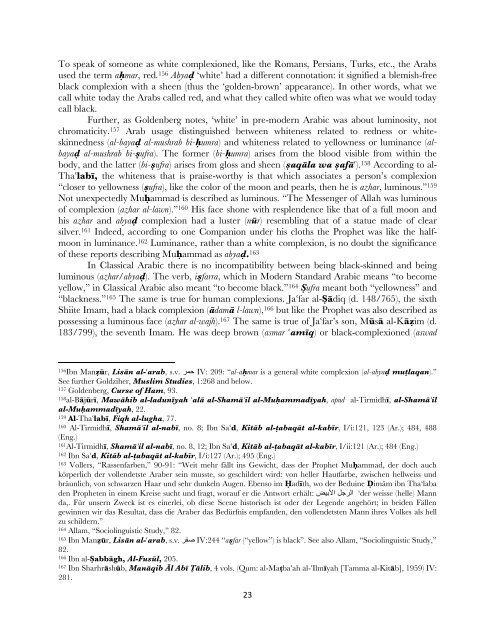Muhammad_Article.349.. - Dr. Wesley Muhammad
Muhammad_Article.349.. - Dr. Wesley Muhammad
Muhammad_Article.349.. - Dr. Wesley Muhammad
Create successful ePaper yourself
Turn your PDF publications into a flip-book with our unique Google optimized e-Paper software.
To speak of someone as white complexioned, like the Romans, Persians, Turks, etc., the Arabs<br />
used the term aÈmar, red. 156 Abya∙ ‘white’ had a different connotation: it signified a blemish-free<br />
black complexion with a sheen (thus the ‘golden-brown’ appearance). In other words, what we<br />
call white today the Arabs called red, and what they called white often was what we would today<br />
call black.<br />
Further, as Goldenberg notes, ‘white’ in pre-modern Arabic was about luminosity, not<br />
chromaticity. 157 Arab usage distinguished between whiteness related to redness or whiteskinnedness<br />
(al-baya∙ al-mushrab bi-Èumra) and whiteness related to yellowness or luminance (albaya∙<br />
al-mushrab bi-ßufra). The former (bi-Èumra) arises from the blood visible from within the<br />
body, and the latter (bi-ßufra) arises from gloss and sheen (ßaq§la wa ßaf§#). 158 According to al-<br />
Tha#labÊ, the whiteness that is praise-worthy is that which associates a person’s complexion<br />
“closer to yellowness (ßufra), like the color of the moon and pearls, then he is azhar, luminous.” 159<br />
Not unexpectedly MuÈammad is described as luminous. “The Messenger of Allah was luminous<br />
of complexion (azhar al-lawn).” 160 His face shone with resplendence like that of a full moon and<br />
his azhar and abya∙ complexion had a luster (når) resembling that of a statue made of clear<br />
silver. 161 Indeed, according to one Companion under his cloths the Prophet was like the halfmoon<br />
in luminance. 162 Luminance, rather than a white complexion, is no doubt the significance<br />
of these reports describing MuÈammad as abya∙. 163<br />
In Classical Arabic there is no incompatibility between being black-skinned and being<br />
luminous (azhar/abya∙). The verb, ißfarra, which in Modern Standard Arabic means “to become<br />
yellow,” in Classical Arabic also meant “to become black.” 164 ‘ufra meant both “yellowness” and<br />
“blackness.” 165 The same is true for human complexions. Ja#far al-‘§diq (d. 148/765), the sixth<br />
Shiite Imam, had a black complexion (§dam§ l-lawn), 166 but like the Prophet was also described as<br />
possessing a luminous face (azhar al-wajh). 167 The same is true of Ja#far’s son, Mås§ al-K§íim (d.<br />
183/799), the seventh Imam. He was deep brown (asmar #amÊq) or black-complexioned (aswad<br />
156 Ibn Maníår, Lis§n al-#arab, s.v. رمح IV: 209: “al-aÈmar is a general white complexion (al-abya∙ muãlaqan).”<br />
See further Goldziher, Muslim Studies, 1:268 and below.<br />
157 Goldenberg, Curse of Ham, 93.<br />
158 al-B§jårÊ, Maw§hib al-ladunÊyah #al§ al-Sham§"il al-MuÈammadÊyah, apud al-TirmidhÊ, al-Sham§"il<br />
al-MuÈammadÊyah, 22.<br />
159 Al-Tha#labÊ, Fiqh al-lugha, 77.<br />
160 Al-TirmidhÊ, Sham§"il al-nabÊ, no. 8; Ibn Sa#d, Kit§b al-ãabaq§t al-kabÊr, I/i:121, 123 (Ar.); 484, 488<br />
(Eng.)<br />
161 Al-TirmidhÊ, Sham§"il al-nabÊ, no. 8, 12; Ibn Sa#d, Kit§b al-ãabaq§t al-kabÊr, I/ii:121 (Ar.); 484 (Eng.)<br />
162 Ibn Sa#d, Kit§b al-ãabaq§t al-kabÊr, I/i:127 (Ar.); 495 (Eng.)<br />
163 Vollers, “Rassenfarben,” 90-91: “Weit mehr fällt ins Gewicht, dass der Prophet MuÈammad, der doch auch<br />
körperlich der vollendetste Araber sein musste, so geschildert wird: von heller Hautfarbe, zwischen hellweiss und<br />
bräunlich, von schwarzen Haar und sehr dunkeln Augen. Ebenso im \adÊth, wo der Beduine 4imâm ibn Tha‘laba<br />
den Propheten in einem Kreise sucht und fragt, worauf er die Antwort erhält: ضيبلأا لجرلا ‘der weisse (helle) Mann<br />
da,. Für unsern Zweck ist es einerlei, ob diese Scene historisch ist oder der Legende angehört; in beiden Fällen<br />
gewinnen wir das Resultat, dass die Araber das Bedürfnis empfanden, den vollendetsten Mann ihres Volkes als hell<br />
zu schildern.”<br />
164 Allam, “Sociolinguistic Study,” 82.<br />
165 Ibn Maníår, Lis§n al-#arab, s.v. رفص IV:244 “aßfar (“yellow”) is black”. See also Allam, “Sociolinguistic Study,”<br />
82.<br />
166 Ibn al-‘abb§gh, Al-Fusål, 205.<br />
167 Ibn Sharhr§shåb, Man§qib $l AbÊ •§lib, 4 vols. (Qum: al-Maãba#ah al-#IlmÊyah [Tamma al-Kit§b], 1959) IV:<br />
281.<br />
23

















